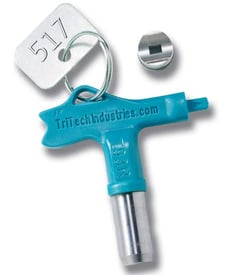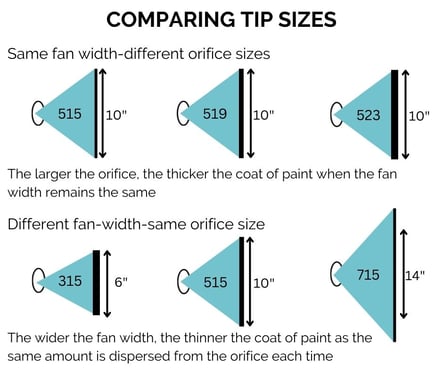Faced with a wall of multicoloured spray tips with peculiar numbers could make your mind boggle as much as algebra did at school. However daunting this may seem, once you crack the number code, you’ll start to get a grasp on understanding the right tip for your job.
Why is your Spray Tip Choice Important?
Spray tips are available to spray a whole array of coatings including oil-based enamels, clear acrylics, latex and polyurethane to name but a few. Depending on your spray tip, you can carry out precision work or complete rapid large surface coverage. Essentially the spray tip regulates how much paint is projected from the gun as well as how wide the fan pattern will be. Through your tip choice you are controlling the paint flow, paint wastage and project cost.
Choosing your Tip
The first step in selecting your spray tip is to find your paint and read the specification sheet to find out which tip is recommended for your paint. It is also worth looking at the sprayers maximum flow rate. A tip must always have a lower flow rate than the maximum machine flow rate. This is because as the tip wears and the orifice becomes bigger, the flow rate will increase. Once you have selected your paint and looked at the spray guidance, you will need to match the tip size with the fan width to find your spray tip number. Finally you should check your spray tip is compatible with your spray paint machine. As a general rule of thumb, the lighter the coating the smaller spray tip you need whereas heavier coatings require a larger tip.
What Does the Spray Tip Number Mean?

Tips will be marked with a 3 digit number. The first number (when multiplied by 2) indicates how wide the fan pattern is when sprayed from 12” from the surface. The second two numbers represent the orifice size in thousandths of an inch, essentially telling you how much paint will leave the gun.
Orifice Size
The spray tip orifice is where paint atomisation occurs. In terms of orifice size (the second two numbers) these are the recommendations for a selection of paints. Of course, always refer to the product specifications for more explicit instructions and recommendations.
- Lacquer or stains- 0.009-0.013
- Oil-based paints- 0.013-0.015
- Latex paints- 0.015-0.019
- Heavy latex, epoxy, fireproofing-0.021-0.025
Fan Size
Whilst the numbers on the spray tip give guidance on the width of the spray pattern, the pressure setting and paint choice can impact the fan pattern by up to 2”. When considering the fan size (the first number) remember this:
A Wide Fan means:
- A Wider area of paint applied
- Increased production as faster coverage
- Thinner coat
- Less defined spray
- More overspray
- Less control
- Great for big projects that need a vast area of paint coverage
A Narrow Fan Means:
- Thicker paint coverage
- A narrow area of paint applied
- Defined Spray Pattern
- Less Overspray
- Better Control
- Great for small/precision projects or confined spaces
- Slower coverage so less productive
Comparing Spray Tip Sizes

It is the combination of the two numbers that determines how thick the application is. For example 317 and 517 tips have the same orifice and therefore the same amount of paint leaving the gun. However the 517 would have a wider fan pattern (10”) and therefore a thinner coating as it is the same amount of paint but dispersed more widely. A tip with a 0.15 orifice is a great recommendation when you are starting out as it is suitable for a variety of applications.
Monitoring Tip Wear and Tear
Tritech spray tips are made from hard tungsten carbide which measures 93 on the Rockwell Scale of Hardness (for context diamonds measure 100). Despite being designed from the strongest materials, spray tips will still wear over time since all paints contain abrasive components. You will get around 300-600 litres of paint sprayed using one spray spray tip before it needs replacing. A new tip will create a spray pattern with a soft and thinner coated edge. As the tip wears, the edge becomes more defined, the fan size decreases and you will need more paint for the same coverage. If you are noticing a round spray pattern rather than a narrow one, it is a sign the tip needs replacing. A worn tip means the orifice size increases and the fan will decrease. Continuing to work with a worn tip will cost you money since it increases overspray and means you will need to do more passes to cover the surface; that’s a lot of wasted paint and increased labour!
Spray Tips At CES

At CES we offer Tritech Spray Tips including the Contractor Pro Airless Spray Tip and the Ultra Fine Finish Low Pressure Airless Spray Tip. These tips are long lasting and high quality for the professional painter. Furthermore they’re loaded with patented and exclusive features that give a consistent, dependable performance day-in and day-out even in the most demanding work environments. The Ultra Fine Finish Low Pressure Airless Spray Tip is a unique double-orifice spray tip. Which atomizes the coating twice. Each time finer than the first to achieve an ultra fine finish at very low pressure levels. For further information of advice on compatible machines such as The TriTech T7 or the QTech QT290, contact us on 01494 715472 or email sales@ces-hire.com



